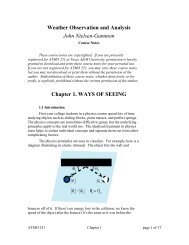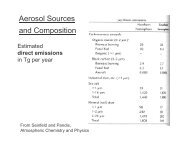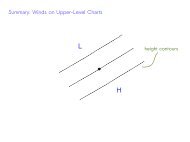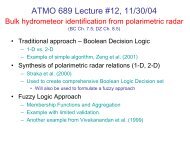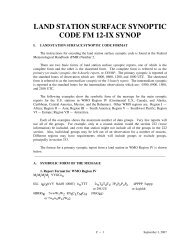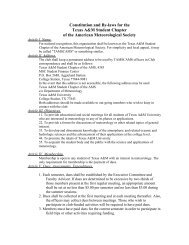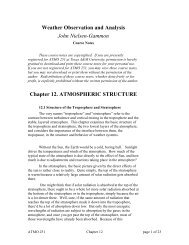Chapter 13: Fronts and Frontogenesis - Texas A&M University
Chapter 13: Fronts and Frontogenesis - Texas A&M University
Chapter 13: Fronts and Frontogenesis - Texas A&M University
You also want an ePaper? Increase the reach of your titles
YUMPU automatically turns print PDFs into web optimized ePapers that Google loves.
from each other <strong>and</strong> its north <strong>and</strong> south sides will be moving toward each<br />
other.<br />
A useful quantity in connection with deformation is the axis of<br />
dilatation. This is the axis along which the imaginary object would be<br />
stretched (or dilated) most strongly. In the example above, the axis of<br />
dilatation is oriented east-west.<br />
Now take the example above <strong>and</strong> rotate it counterclockwise by 45<br />
degrees. Presumably we have not altered the magnitude of the<br />
deformation, since objects would still be stretched or shrunk by the same<br />
amount as before. The axis of dilatation will have rotated too, <strong>and</strong> now<br />
would be oriented northeast-southwest.<br />
With the rotated wind pattern, consider the mathematical terms in<br />
the definition of deformation. After the rotation, each of the derivatives in<br />
the first term in parentheses is suddenly zero! (Don’t take my word for it,<br />
work it out for yourself.) But not to worry, the second term is now<br />
nonzero. Since v increases in the positive x direction, the first derivative is<br />
positive. Since u increases in the positive y direction, the other derivative<br />
is also positive. The lesson here is that there’s really nothing special about<br />
which of the terms contributes to deformation.<br />
ATMO 251 <strong>Chapter</strong> <strong>13</strong> page 14 of 22



